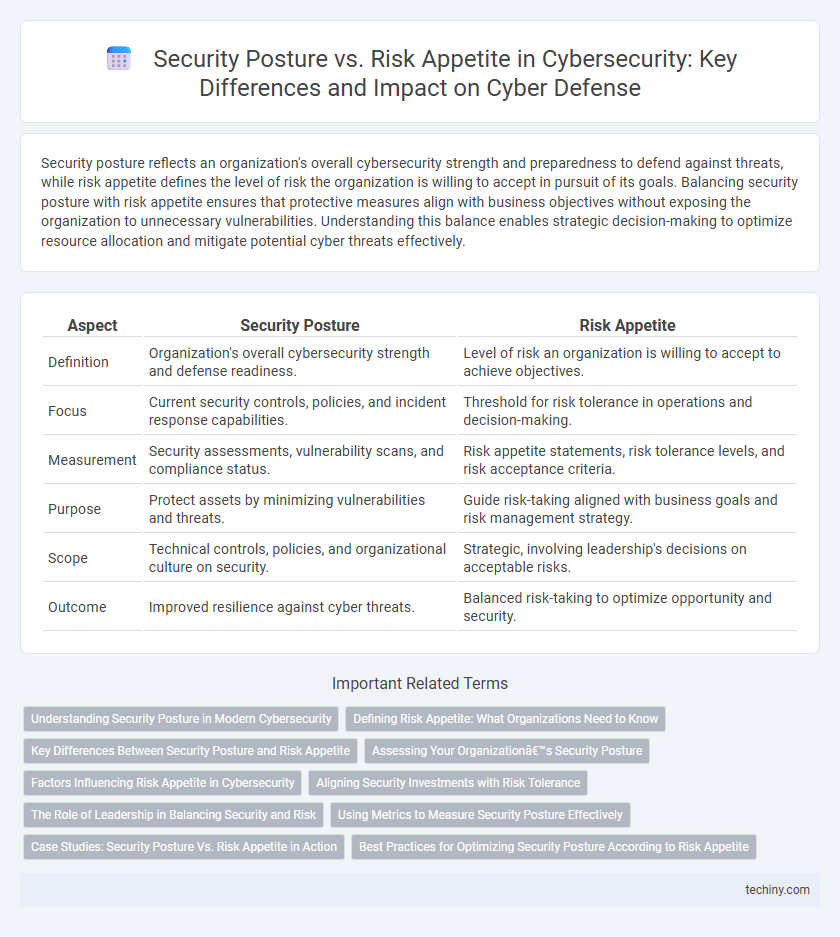Security posture reflects an organization's overall cybersecurity strength and preparedness to defend against threats, while risk appetite defines the level of risk the organization is willing to accept in pursuit of its goals. Balancing security posture with risk appetite ensures that protective measures align with business objectives without exposing the organization to unnecessary vulnerabilities. Understanding this balance enables strategic decision-making to optimize resource allocation and mitigate potential cyber threats effectively.
Table of Comparison
| Aspect | Security Posture | Risk Appetite |
|---|---|---|
| Definition | Organization's overall cybersecurity strength and defense readiness. | Level of risk an organization is willing to accept to achieve objectives. |
| Focus | Current security controls, policies, and incident response capabilities. | Threshold for risk tolerance in operations and decision-making. |
| Measurement | Security assessments, vulnerability scans, and compliance status. | Risk appetite statements, risk tolerance levels, and risk acceptance criteria. |
| Purpose | Protect assets by minimizing vulnerabilities and threats. | Guide risk-taking aligned with business goals and risk management strategy. |
| Scope | Technical controls, policies, and organizational culture on security. | Strategic, involving leadership's decisions on acceptable risks. |
| Outcome | Improved resilience against cyber threats. | Balanced risk-taking to optimize opportunity and security. |
Understanding Security Posture in Modern Cybersecurity
Security posture in modern cybersecurity refers to the overall strength and effectiveness of an organization's defense mechanisms against cyber threats, including policies, controls, and technologies implemented to protect assets. It involves continuous monitoring, threat detection, vulnerability management, and incident response capabilities that determine the organization's resilience to attacks. Understanding security posture enables organizations to identify weaknesses, prioritize cybersecurity investments, and align defense strategies with evolving threat landscapes.
Defining Risk Appetite: What Organizations Need to Know
Defining risk appetite involves understanding the level of risk an organization is willing to accept to achieve its objectives, which directly impacts its cybersecurity strategies. Organizations must quantify acceptable risk thresholds by evaluating potential threats, vulnerabilities, and the impact of security incidents on business operations. A clear risk appetite enables precise alignment of security investments and resource allocation, enhancing overall security posture against evolving cyber threats.
Key Differences Between Security Posture and Risk Appetite
Security posture refers to an organization's overall cybersecurity strength, encompassing policies, controls, and practices designed to defend against threats. Risk appetite defines the level of cybersecurity risk an organization is willing to accept in pursuit of its objectives, balancing potential losses with business opportunities. Key differences include security posture as a measurable state of defense readiness, while risk appetite guides strategic decisions on risk tolerance and resource allocation.
Assessing Your Organization’s Security Posture
Assessing your organization's security posture involves evaluating the effectiveness of current cybersecurity measures, including vulnerability management, threat detection, and incident response capabilities. This assessment provides a comprehensive view of risks and controls, enabling alignment with your defined risk appetite to ensure resource allocation matches acceptable threat levels. Regular security posture evaluations support proactive decision-making and help maintain resilience against evolving cyber threats.
Factors Influencing Risk Appetite in Cybersecurity
Risk appetite in cybersecurity is influenced by organizational culture, regulatory requirements, and the potential impact of cyber threats on business operations. Factors such as financial resources, industry-specific risks, and stakeholder expectations shape an organization's tolerance for cyber risk. Understanding these variables enables tailored security postures that balance protection efforts with acceptable risk levels.
Aligning Security Investments with Risk Tolerance
Aligning security investments with risk tolerance ensures organizations allocate resources effectively to mitigate threats within acceptable risk levels. A strong security posture reflects the organization's ability to defend against cyber threats, while risk appetite defines the extent of risk exposure the organization is willing to accept. Balancing these factors enables targeted investment in security controls that support business objectives and regulatory compliance.
The Role of Leadership in Balancing Security and Risk
Effective cybersecurity leadership involves aligning security posture with the organization's risk appetite to ensure balanced protection without overextending resources. Leaders must continuously assess threats and vulnerabilities while making strategic decisions that reflect the company's tolerance for risk, shaping policies and response protocols accordingly. This approach fosters a proactive security culture that adapts to evolving cyber threats while supporting business objectives.
Using Metrics to Measure Security Posture Effectively
Security posture can be accurately assessed using quantitative metrics such as the number of detected vulnerabilities, incident response times, and compliance scores with industry standards like NIST or ISO 27001. Measuring these metrics reveals how well an organization's defenses align with its defined risk appetite, providing actionable insights into potential exposure and mitigation effectiveness. Continuous monitoring and data-driven evaluations enable businesses to adjust security strategies, ensuring optimal protection against emerging cyber threats while adhering to acceptable risk thresholds.
Case Studies: Security Posture Vs. Risk Appetite in Action
Case studies reveal how organizations with robust security postures continuously monitor vulnerabilities and implement layered defenses, effectively minimizing operational disruptions despite varying risk appetites. Companies with high risk appetites often face greater incident frequencies but can leverage agile response strategies to contain damage, as seen in sectors like finance and healthcare. These real-world examples emphasize aligning security investments with organizational risk tolerance to optimize resilience and business continuity.
Best Practices for Optimizing Security Posture According to Risk Appetite
Optimizing security posture according to risk appetite involves aligning cybersecurity controls with an organization's risk tolerance and business objectives. Best practices include conducting regular risk assessments to identify potential threats, implementing layered defense mechanisms proportional to identified risks, and continuously monitoring and adjusting security policies to reflect changes in risk appetite. Investing in employee training and leveraging threat intelligence further enhances the ability to mitigate risks while maintaining operational flexibility.
Security Posture vs Risk Appetite Infographic

 techiny.com
techiny.com